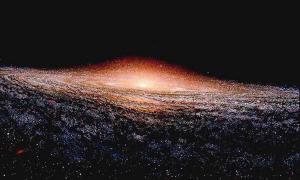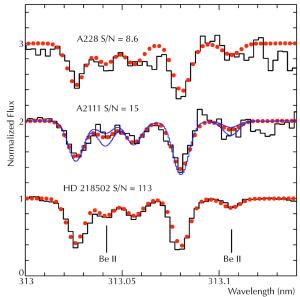Blog
Beryllium Sphere
3 February 2015
 Cambridge University
Cambridge UniversityYesterday I talked about measuring the age of a star, but what about a galaxy. For example, how old is our Milky Way galaxy? Given that stars are being born and dying within a galaxy all the time, is it even possible to talk about the age of a galaxy? It turns out we can determine the age of our galaxy, and uses an elemental trick.
One of the basic ways to look at the age of the Milky Way is to look at globular clusters. These are dense clusters of stars that are distributed in a kind of halo around our galaxy. We know that the stars within a globular cluster form around the same time, and we can determine their age by looking at things such as the percentage of their stars that are red dwarfs, or the temperatures of their white dwarfs.
The red dwarf measure is useful because red dwarfs can last for trillions of years, unlike larger stars which only last a few billion. So if a group of stars form at the same time, the larger stars will die off sooner, while the red dwarfs continue to shine. So the more red dwarfs a globular cluster has, the older it is. The white dwarf method relies on the fact a white dwarf is the remnant of a Sun-like star. Once a white dwarf forms, it has no way to produce new energy, so it gradually cools. The cooler the white dwarfs in a globular cluster, the older it is.
It turns out that the oldest of the globular clusters surrounding our galaxy are about 13 billion years old, which means the Milky Way must be at least that old. But when we look at the oldest red dwarfs in these clusters, we find that they aren’t first generation stars. They contain elements that could only be formed by earlier stars, and that means stars must have lived and died in the Milky Way before these globular clusters formed. So the Milky Way is older that 13 billion years, but how much older?
 ESO
ESOThat’s where the elemental trick comes in. In this case, the element beryllium. While most of the elements beyond hydrogen and helium are produced in the cores of stars, not all of them are. Some are produced by the radioactive decay of heavier elements, or in the case of beryllium-9, high energy cosmic rays. Cosmic rays are typically protons or helium nuclei that zip through the galaxy at near-light speeds. When these cosmic rays collide with heavier nuclei drifting through space, they cause the nuclei to break apart into lighter elements. One of these is beryllium. Since cosmic rays are pervasive throughout the early galaxy due to early star production and early supernovae, the amount of beryllium in interstellar space builds up over time. By measuring beryllium levels in an old star, you can then determine how long the galaxy was around before the star formed.
These levels were measured in a 2004 paper in Astronomy and Astrophysics, and the result was that the galaxy is about 13.6 billion years old.1 What’s interesting is that the age of the universe is just shy of 13.8 billion years, which means that our Milky Way must have been one of the early galaxies, forming just after the “dark ages” of the universe, when the first stars were just beginning to shine.
Pasquini, L., et al. “Beryllium in turnoff stars of NGC 6397: Early Galaxy spallation, cosmochronology and cluster formation.” Astronomy & Astrophysics 426.2 (2004): 651-657. ↩︎